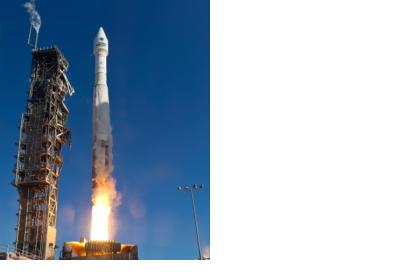On 4 February 2013 NASA's Landsat Data Continuity Mission (LDCM) lifted off into space aboard an Atlas V rocket from Vandenberg Air Force Base in California.
The LDCM spacecraft separated from the rocket 79 minutes after launch and the first signal was received 3 minutes later at a ground station in Svalbard, Norway. The solar arrays deployed 86 minutes after launch, and the spacecraft is generating power from them. LDCM is on course to reach its operational, sun-synchronous, polar orbit 438 miles (705 kilometers) above Earth within two months. LDCM will go through a check-out phase for the next three months. Afterward, operational control will be transferred to NASA's mission partner, the Department of the Interior's U.S. Geological Survey (USGS), and the satellite will be renamed Landsat 8. Data will be archived and distributed free over the Internet from the Earth Resources and Science (EROS) center in Sioux Falls, S.D. Distribution of Landsat 8 data from the USGS archive is expected to begin within 100 days of launch.
The use of Landsat data been transformed in recent years by advancements in computing power and the decision by USGS to allow free online access to the information. This revolution has allowed scientists to detect changes over time to our planet and has enabled a host of applications based on Landsat measurements to be developed by researchers, the private sector, and state, local, and tribal governments.
The spacecraft carries two instruments, the Operational Land Imager (OLI) and Thermal Infrared Sensor (TIRS). The measurements will be compatible with data from past Landsat satellites, but the LDCM instruments use advanced technology to improve reliability, sensitivity, and data quality.
OLI will continue observations currently made by Landsat 7 in the visible, near infrared, and shortwave infrared portions of the electromagnetic spectrum. It also will take measurements in two new bands, one to observe high-altitude cirrus clouds and another to observe atmospheric aerosols as well as water quality in lakes and shallow coastal waters. OLI's new design has fewer moving parts than instruments on previous Landsat satellites.
TIRS will collect data on heat emitted from Earth's surface in two thermal bands, as compared with a single thermal band on previous Landsat satellites. These thermal band observations are becoming increasingly vital to monitoring water consumption, especially in the arid western United States.
Additionally, Landsat 5 successfully set the new Guinness World Records title for 'Longest-operating Earth observation satellite’ as stated in an e-mail from Guinness World Records sent to NASA Goddard Space Flight Center in Greenbelt, Md. Outliving its three-year design life, Landsat 5 delivered high-quality, global data of Earth's land surface for 28 years and 10 months.

